Brother BAS-326H, BAS-311HN User Manual
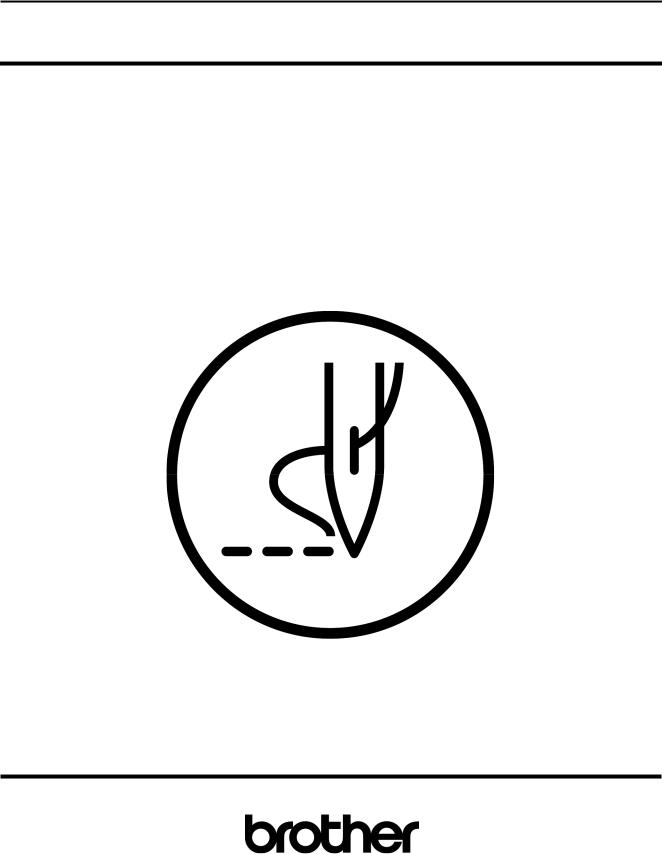
BAS-311HN BAS-326H
INSTRUCTION MANUAL
Please read this manual before using the machine.
Please keep this manual within easy reach for quick reference.
DIRECT DRIVE
PROGRAMMABLE ELECTRONIC PATTERN SEWER
Thank you very much for buying a BROTHER sewing machine. Before using your new machine, please read the safety instructions below and the explanations given in the instruction manual.
With industrial sewing machines, it is normal to carry out work while positioned directly in front of moving parts such as the needle and thread take-up lever, and consequently there is always a danger of injury that can be caused by these parts. Follow the instructions from training personnel and instructors regarding safe and correct operation before operating the machine so that you will know how to use it correctly.
BAS-311HN, BAS-326H

SAFETY INSTRUCTIONS
[1] Safety indications and their meanings
This instruction manual and the indications and symbols that are used on the machine itself are provided in order to ensure safe operation of this machine and to prevent accidents and injury to yourself or other people.
The meanings of these indications and symbols are given below.
Indications
DANGER |
The instructions which follow this term indicate situations where failure to follow the |
instructions will result in death or serious injury. |
|
|
|
WARNING |
The instructions which follow this term indicate situations where failure to follow the |
instructions could result in death or serious injury. |
|
|
|
CAUTION |
The instructions which follow this term indicate situations where failure to follow the |
instructions may result in minor or moderate injury. |
|
|
|
Symbols |
|



This symbol (  ) indicates something that you should be careful of. The picture inside the triangle indicates the nature of the caution that must be taken.
) indicates something that you should be careful of. The picture inside the triangle indicates the nature of the caution that must be taken.
(For example, the symbol at left means “beware of injury”.)
This symbol (  ) indicates something that you must not do.
) indicates something that you must not do.
This symbol (  ) indicates something that you must do. The picture inside the circle indicates the nature of the thing that must be done.
) indicates something that you must do. The picture inside the circle indicates the nature of the thing that must be done.
(For example, the symbol at left means “you must make the ground connection”.)
BAS-311HN, BAS-326H |
i |
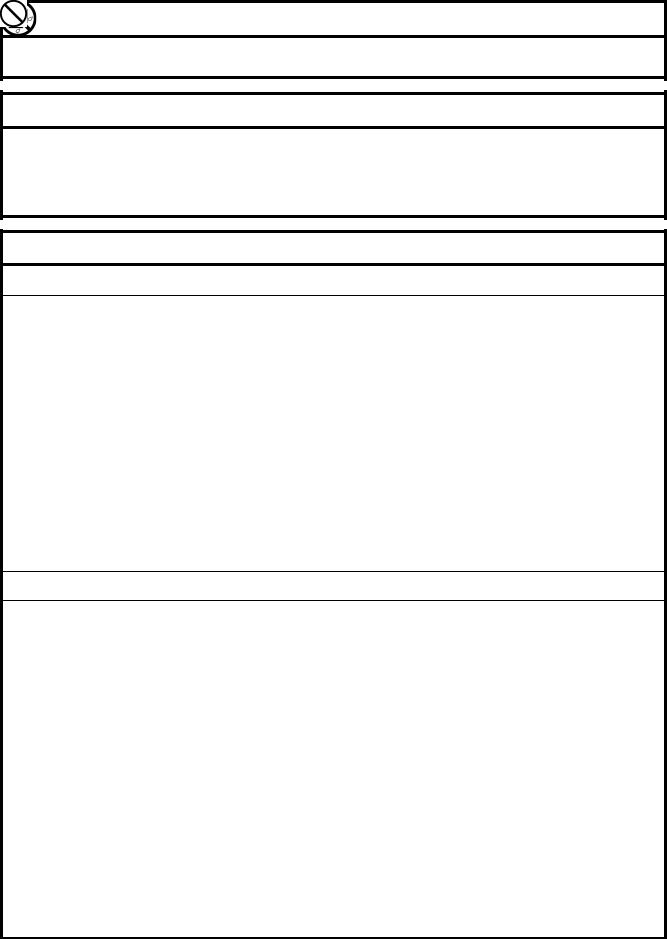
[2] Notes on safety
 DANGER
DANGER
Wait at least 5 minutes after turning off the power switch and disconnecting the power cord from the wall outlet before opening the control box cover. Touching areas where high voltages are present can result in severe injury.
 WARNING
WARNING
Do not allow any liquids to get onto this sewing machine, otherwise fire, electric shocks or operating problems may occur.
If any liquid gets inside the sewing machine (machine head or control box), immediately turn off the power and disconnect the power plug from the electrical outlet, and then contact the place of purchase or a qualified technician.
 CAUTION
CAUTION
Environmental requirements
Use the sewing machine in an area which is free from sources of strong electrical noise such as electrical line noise or static electric noise.
Sources of strong electrical noise may cause problems with correct operation.
Any fluctuations in the power supply voltage should be within ±10% of the rated voltage for the machine. Voltage fluctuations which are greater than this may cause problems with correct operation.
The power supply capacity should be greater than the requirements for the sewing machine's power consumption.
Insufficient power supply capacity may cause problems with correct operation.
Do not connect anything to the USB port other than the USB memory. If this is not observed, problems with operation may result.
The pneumatic delivery capability should be greater than the requirements for the sewing machine's total air consumption.
Insufficient pneumatic delivery capability may cause problems with correct operation.
The ambient temperature should be within the range of 5°C to 35°C during use.
Temperatures which are lower or higher than this may cause problems with correct operation.
The relative humidity should be within the range of 45% to 85% during use, and no dew formation should occur in any devices.
Excessively dry or humid environments and dew formation may cause problems with correct operation.
In the event of an electrical storm, turn off the power and disconnect the power cord from the wall outlet. Lightning may cause problems with correct operation.
Installation
Machine installation should only be carried out by a qualified technician.
Contact your Brother dealer or a qualified electrician for any electrical work that may need to be done.
The sewing machine weighs approximately 88 kg. The installation should be carried out by three or more people.
Do not connect the power cord until installation is complete. If the foot switch is depressed by mistake, the sewing machine might start operating and injury could result.
Hold the machine head with both hands when tilting it back or returning it to its original position. Furthermore, do not apply excessive force when tilting back the machine head. The sewing machine may become unbalanced and fall down, and serious injury or damage to the sewing machine may result.
Be sure to connect the ground. If the ground connection is not secure, you run a high risk of receiving a serious electric shock, and problems with correct operation may also occur.
All cords should be secured at least 25 mm away from any moving parts. Furthermore, do not excessively bend the cords or secure them too firmly with staples, otherwise there is the danger that fire or electric shocks could occur.
Install the safety covers to the machine head and motor.
If using a work table which has casters, the casters should be secured in such a way so that they cannot move.
Be sure to wear protective goggles and gloves when handling the lubricating oil and grease, so that they do not get into your eyes or onto your skin. If the oil and grease get into your eyes or onto your skin, inflammation can result.
Furthermore, do not drink or eat the lubricating oil or grease. They may cause diarrhea or vomiting.
Keep the oil out of the reach of children.
ii |
BAS-311HN, BAS-326H |
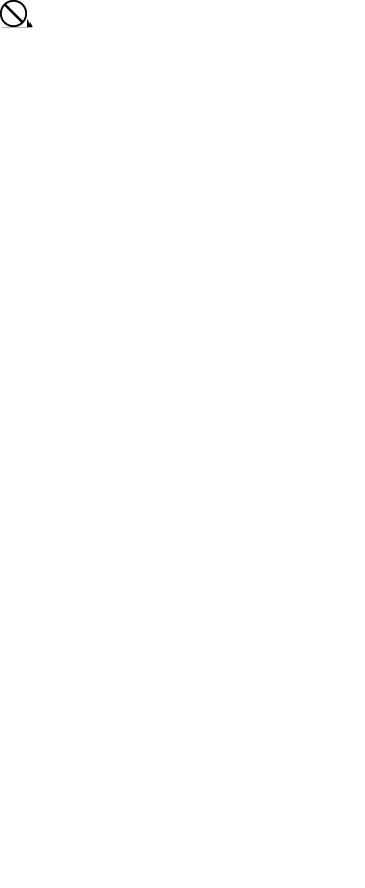
CAUTION |
|
||
Sewing |
|
|
|
To prevent problems, do not use objects with sharp |
If using a work table which has casters, the casters |
||
points to operate the LCD panel. |
should be secured in such a way so that they cannot |
||
This sewing machine should only be used by |
move. |
|
|
|
|
||
operators who have received the necessary training |
Attach all safety devices before using the sewing |
||
in safe use beforehand. |
machine. If the machine is used without these |
||
The sewing machine should not be used for any |
devices attached, injury may result. |
|
|
|
|
||
applications other than sewing. |
Do not touch any of the moving parts or press any |
||
Be sure to wear protective goggles when using the |
objects against the machine while sewing, as this |
||
machine. |
may result in personal injury or damage to the |
||
If goggles are not worn, there is the danger that if a |
machine. |
|
|
needle breaks, parts of the broken needle may enter |
If an error occurs in machine operation, or if abnormal |
||
your eyes and injury may result. |
|||
noises or smells are noticed, immediately turn off the |
|||
Turn off the power switch at the following times. If the |
|||
power switch. Then contact your nearest Brother |
|||
foot switch is depressed by mistake, the sewing |
dealer or a qualified technician. |
|
|
machine might start operating and injury could result. |
If the machine develops a problem, contact |
your |
|
• When replacing the bobbin and needle |
|||
nearest Brother dealer or a qualified technician. |
|
||
• When not using the machine and when leaving the |
|
||
|
|
||
machine unattended |
|
|
|
|
|
||
Cleaning |
|
||
Turn off the power switch before carrying out |
Be sure to wear protective goggles and gloves when |
||
cleaning. If the foot switch is depressed by mistake, |
handling the lubricating oil and grease, so that they |
||
the sewing machine might start operating and injury |
do not get into your eyes or onto your skin. If the oil |
||
could result. |
and grease get into your eyes or onto your skin, |
||
|
inflammation can result. |
|
|
|
Furthermore, do not drink or eat the lubricating oil or |
||
|
grease. They may cause diarrhea or vomiting. |
|
|
|
Keep the oil out of the reach of children. |
|
|
|
|
||
Maintenance and inspection |
|
||
Maintenance and inspection of the sewing machine |
Hold the machine head with both hands when tilting it |
||
should only be carried out by a qualified technician. |
back or returning it to its original position. |
|
|
Ask your Brother dealer or a qualified electrician to |
Furthermore, do not apply excessive force |
when |
|
tilting back the machine head. The sewing machine |
|||
carry out any maintenance and inspection of the |
|||
may become unbalanced and fall down, and serious |
|||
electrical system. |
|||
injury or damage to the sewing machine may result. |
|||
Turn off the power switch and disconnect the power |
|||
If the power switch needs to be left on when carrying |
|||
cord before carrying out the following operations. If |
|||
out some adjustment, be extremely careful to observe |
|||
the foot switch is depressed by mistake, the sewing |
|||
all safety precautions. |
|
||
machine might start operating and injury could result. |
|
||
|
|
||
• Inspection, adjustment and maintenance |
When replacing parts and installing optional |
||
• Replacing consumable parts such as the rotary |
accessories, be sure to use only genuine Brother |
||
hook |
parts. |
|
|
Disconnect the air hoses from the air supply and wait |
Brother will not be held responsible for any accidents |
||
or problems resulting from the use of non-genuine |
|||
for the needle on the pressure gauge to drop to “0” |
|||
parts. |
|
||
before carrying out inspection, adjustment and repair |
|
||
|
|
||
of any parts which use the pneumatic equipment. |
If any safety devices have been removed, be |
||
|
absolutely sure to re-install them to their original |
||
|
positions and check that they operate correctly before |
||
|
using the machine. |
|
|
|
To prevent accidents and problems, do not modify |
||
|
the machine yourself. |
|
|
|
Brother will not be held responsible for any accidents |
||
|
or problems resulting from modifications made to the |
||
|
machine. |
|
|
|
|
||
BAS-311HN, BAS-326H |
iii |
||
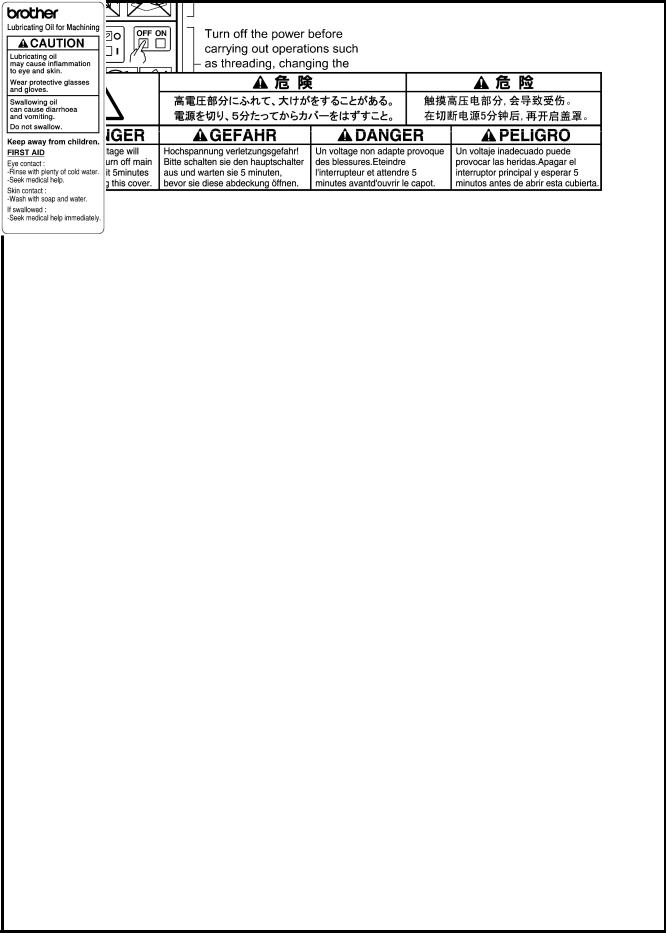
[3] Warning labels
The following warning labels appear on the sewing machine.
Please follow the instructions on the labels at all times when using the machine. If the labels have been removed or are difficult to read, please contact your nearest Brother dealer.
1
2
.
*Safety devices
Devices such as eye guard, finger guard, thread take-up cover, side cover,
rear cover, solenoid cover, inner cover, outer cover, fixed cover and gas spring support cover
3 
4
5
6
Be careful not to get your hand caught when tilting back |
8 |
the machine head and returning it to its original position. |
Be sure to connect the ground.
If the ground connection is not secure, you run a high risk of receiving a serious electric shock, and problems with correct operation may also occur.
Direction of operation
Be careful to avoid injury from moving parts.
Do not hold, otherwise problems with operation or injury may occur.
iv |
BAS-311HN, BAS-326H |
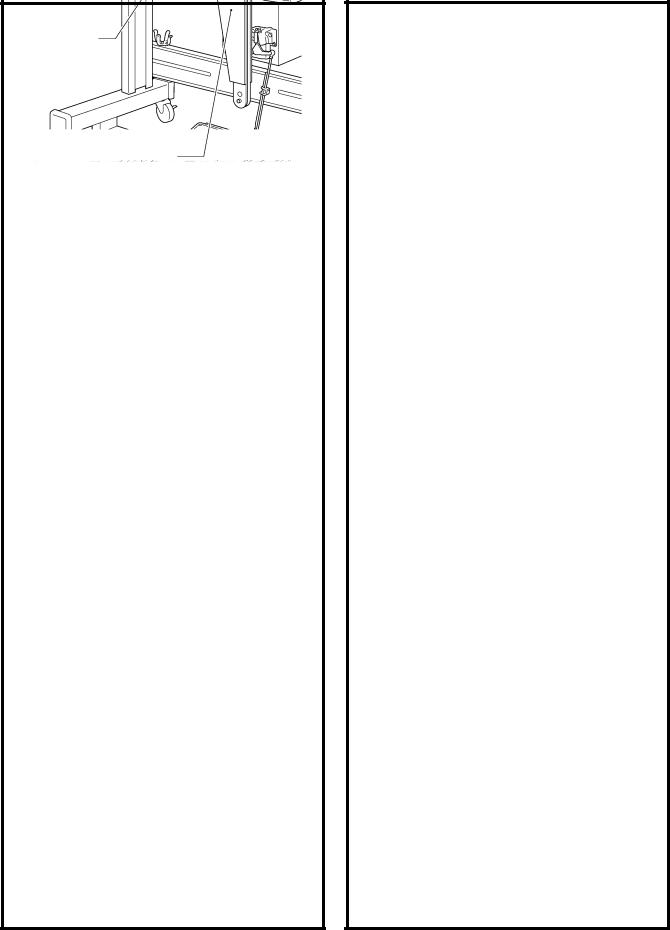
BAS-311HN |
BAS-326H |
|
Solenoid cover |
|
Solenoid cover |
Inner cover L |
Inner cover L |
Outer cover |
|
Outer cover |
Fixed cover |
Fixed cover |
|
Rear cover |
Rear cover |
|
Side cover
Side cover
Thread take-up cover
Thread take-up cover
Eye guard |
Eye guard |
|
Finger guard |
Finger guard |
|
|
||
Inner cover R |
Inner cover R |
|
Outer cover |
||
Outer cover |
||
Fixed cover |
||
Fixed cover |
||
|
Gas spring support cover |
Gas spring support cover |
|
|
3504B |
3505B |
BAS-311HN, BAS-326H |
v |
CONTENTS
1. NAMES OF MAJOR PARTS ................ |
1 |
2. SPECIFICATIONS ................................ |
2 |
3. INSTALLATION.................................... |
3 |
3-1. Table processing diagram ................................ |
3 |
3-2. Installing the control box................................... |
4 |
3-3. Installing the oil pan.......................................... |
4 |
3-4. Installing the machine head.............................. |
5 |
3-5. Installing the LCD panel ................................... |
8 |
3-6. Installing the two-pedal foot switch ................. |
9 |
3-7. Connecting the cords........................................ |
9 |
3-8. Connecting the ground wire.............................. |
13 |
3-9. Connecting the power cord............................... |
14 |
3-10. Installing the cotton stand............................... |
17 |
3-11. Installing the pneumatic unit |
|
(pneumatic work clamp specifications)............. |
18 |
3-12. Installing the eye guard .................................. |
19 |
3-13. Installing the side cover and rear cover.......... |
19 |
3-14. Lubrication ...................................................... |
20 |
3-15. Installing the machine head fixing bolt ........... |
21 |
3-16. Checking the machine head switch................ |
21 |
4. PREPARATION BEFORE SEWING..... |
22 |
4-1. Installing the needle.......................................... |
22 |
4-2. Threading the upper thread .............................. |
23 |
4-3. Winding the lower thread.................................. |
25 |
4-4. Installing the bobbin case ................................. |
27 |
4-5. Thread tension.................................................. |
28 |
4-5-1. Lower thread tension ........................... |
28 |
4-5-2. Upper thread tension ........................... |
29 |
4-5-2-1. Upper thread tension |
|
(Medium-weight materials |
|
specifications <-03[]>, |
|
Heavy-weight materials |
|
specifications <-05[]>) ................... |
29 |
4-5-2-2. Upper thread tension |
|
(Seatbelt specifications <-07A>) ... |
29 |
4-6. Starting up ........................................................ |
30 |
5. SEWING................................................ |
31 |
5-1. Sewing .............................................................. |
31 |
5-2. Using the STOP switch..................................... |
32 |
6. CLEANING ........................................... |
33 |
6-1. Cleaning the rotary hook................................... |
33 |
6-2. Cleaning the control box air inlet ports ............. |
34 |
6-3. Draining the oil .................................................. |
34 |
6-4. Cleaning the eye guard..................................... |
34 |
6-5. Checking the needle ......................................... |
34 |
6-6. Lubrication......................................................... |
34 |
6-7. Applying grease |
|
(Feed mechanism BAS-311HN) ....................... |
35 |
7. STANDARD ADJUSTMENTS .............. |
37 |
7-1. Checking the machine head switch .................. |
37 |
7-2. Adjusting the sensitivity of the thread |
|
breakage sensor............................................... |
38 |
7-3. Thread take-up spring....................................... |
39 |
7-4. Arm thread guide R........................................... |
39 |
7-5. Adjusting the needle bar height ........................ |
40 |
7-6. Adjusting the needle and rotary hook timing..... |
40 |
7-7. Adjusting the driver (needle guard) position ..... |
41 |
7-8. Adjusting the clearance between the |
|
needle and rotary hook tip ................................ |
41 |
7-9. Adjusting the shuttle race thread guide ............ |
41 |
7-10. Rotary hook lubrication amount ...................... |
42 |
7-11. Adjusting the position of the movable knife .... |
42 |
7-12. Replacing the movable and fixed knives ........ |
44 |
7-13. Installing the feed plate ................................... |
45 |
7-14. Adjusting the thread wiper .............................. |
45 |
7-15. Intermittent presser foot installation position .. |
46 |
7-16. Adjusting the intermittent presser foot ............ |
46 |
7-17. Adjusting the work clamp lift amount .............. |
48 |
7-18. Adjusting the air pressure ............................... |
48 |
7-19. Setting method for standard depression |
|
strokes (foot switch)........................................ |
49 |
7-20. If processing the work clamps and the |
|
feed plate to a shape that matches the |
|
sewing pattern ................................................ |
51 |
8. LIST OF ERROR CODES..................... |
53 |
9. TROUBLESHOOTING.......................... |
59 |
BAS-311HN, BAS-326H
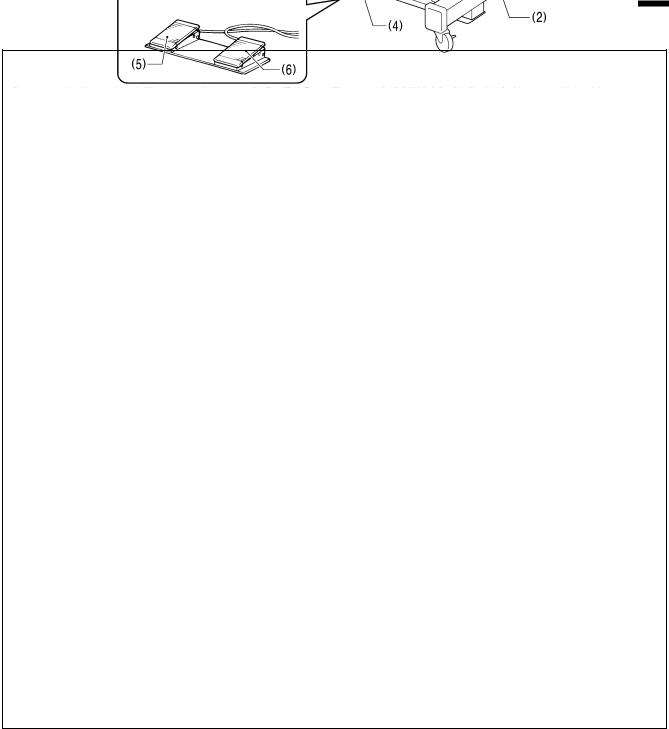
1. NAMES OF MAJOR PARTS
1. NAMES OF MAJOR PARTS
Two-pedal foot switch
3677B
(1) |
Power switch |
Safety devices: |
|
(2) |
Control box |
(11) Finger guard |
|
(3) |
LCD panel |
(12) |
Eye guard |
(4) |
Foot switch |
(13) Thread take-up cover |
|
(5) |
Work clamp switch |
(14) |
Rear cover |
(6)Start switch
(7)STOP switch
(8)Pulley
(9)Cotton stand
(10)Solenoid valve (pneumatic work clamp specifications)
BAS-311HN, BAS-326H |
1 |
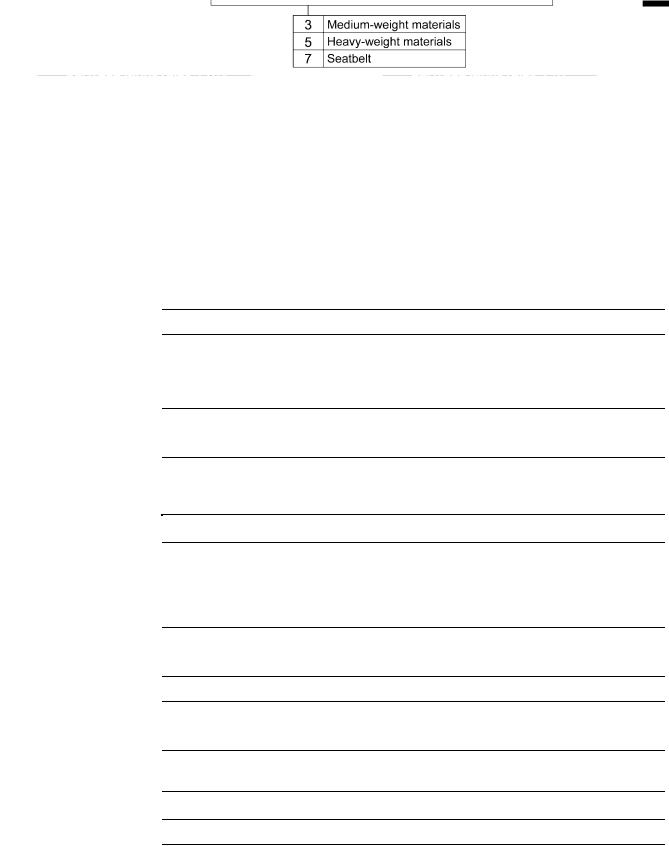
2. SPECIFICATIONS
2. SPECIFICATIONS
3580B
Sewing machine |
|
Lock stitch pattern tacking sewing machine |
|||
|
|
|
|
||
Stitch formation |
|
Single needle lock stitch |
|||
|
|
|
|
|
|
Max. sewing speed |
|
2,800 sti/min |
|
||
|
|
|
|
||
Max. sewing area (XxY) |
BAS-311HN: 150 x 100 mm |
|
BAS-326H: 220 x 100 mm |
||
|
|
|
|
||
Feed mechanism |
|
Intermittent feed, pulse motor drive |
|||
|
|
|
|
||
Stitch length |
|
0.05 − 12.7 mm |
|
||
|
|
||||
Maximum No. of stitches |
20,000 stitches (per program) |
||||
|
|
|
|
|
|
No. of sewing data |
items |
999 (Internal memory, SD card, USB memory) (*1) |
|||
that can be stored |
|
||||
|
Motor-driven work clamp specifications: Pulse motor drive method |
||||
|
|
||||
Work clamp lift method |
Pneumatic work clamp specifications: Pneumatic cylinder method |
||||
Motor-driven work clamp specifications: Integrated-type work clamp |
|||||
|
|
||||
|
|
Pneumatic work clamp specifications: Separate-type work clamp |
|||
Work clamp height |
|
Motor-driven work clamp specifications: Max. 25 mm |
|||
|
Pneumatic work clamp specifications: Max. 30 mm |
||||
|
|
||||
Intermittent presser foot lift |
22 mm |
|
|||
amount |
|
|
|||
|
|
|
|
||
Intermittent presser |
foot |
2 − 4.5 mm, 4.5 − 10 mm or 0 (Default setting 3 mm) |
|||
stroke |
|
||||
|
|
|
|
||
Hook |
|
Double-capacity shuttle hook |
|||
|
|
|
|
||
Wiper device |
|
Standard equipment |
|
||
|
|
|
|
||
Thread trimmer |
|
Standard equipment |
|
||
|
|
|
|
||
Cycle programs |
|
30 |
|
||
|
|
|
|||
Motor |
|
550 W AC servo motor |
|||
|
|
Machine head Approx. 88 kg, LCD panel Approx. 0.8 kg |
|||
Weights |
|
||||
|
Control box 9 kg (Differs depending on destination) |
||||
|
|
||||
|
|
Single-phase 110V / 220V / 230V, 3-phase 220V / 380V / 400V |
|||
Power source |
|
||||
|
(For single-phase 110 V and three-phase 380 V/400 V, the trans box is required.) |
||||
|
|
||||
Air pressure |
|
0.5 MPa 1.8 l/min. |
|
||
|
|
|
|
|
|
(*1) The number of data items and stitches that can be stored will vary depending on the number of stitches in each program.
No guarantees of operation can be given for any media.
2 |
BAS-311HN, BAS-326H |
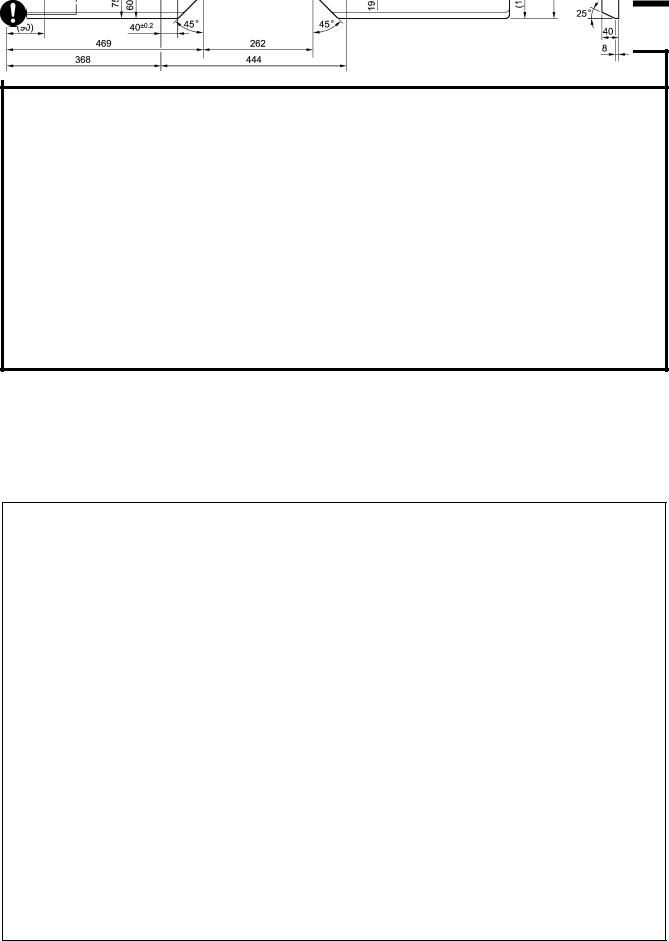
3. INSTALLATION
3. INSTALLATION
 CAUTION
CAUTION
Machine installation should only be carried out by a |
All cords should be secured at least 25 mm away from |
||||||||||
qualified technician. |
any moving parts. Furthermore, do not excessively |
||||||||||
Contact your Brother dealer or a qualified electrician |
bend the |
cords |
or |
secure |
them too |
firmly |
staples, |
||||
otherwise |
there |
is |
the |
danger that |
fire or |
electric |
|||||
for any electrical work that may need to be done. |
|||||||||||
shocks could occur. |
|
|
|
|
|
|
|||||
|
|
|
|
|
|
|
|||||
The sewing machine head weighs approximately |
Be sure |
to |
connect |
the |
ground. |
If |
the |
ground |
|||
88kg. The installation should be carried out by three or |
|||||||||||
connection |
is |
not |
secure, |
you run |
a |
high |
risk of |
||||
more people. |
|||||||||||
receiving a serious electric shock, and problems with |
|||||||||||
|
|||||||||||
Do not connect the power cord until installation is |
correct operation may also occur. |
|
|
|
|||||||
complete. |
Install the |
safety |
covers to |
the machine head and |
|||||||
If the foot switch is depressed by mistake, the sewing |
|||||||||||
motor. |
|
|
|
|
|
|
|
|
|
||
machine might start operating and injury could result. |
|
|
|
|
|
|
|
|
|
||
|
|
|
|
|
|
|
|
|
|
||
Hold the machine head with both hands when tilting it back or returning it to its original position. Furthermore, do not apply excessive force when tilting back the machine head. The sewing machine may become unbalanced and fall down, and serious injury or damage to the sewing machine may result.
3-1. Table processing diagram
•The thickness of the table should be at least 40 mm, and it should be strong enough to bear the weight and vibration of the sewing machine.
•Check that the control box is at least 10 mm away from the leg. If the control box and the leg are too close together, it may result in incorrect sewing machine operation.
3679B
BAS-311HN, BAS-326H |
3 |
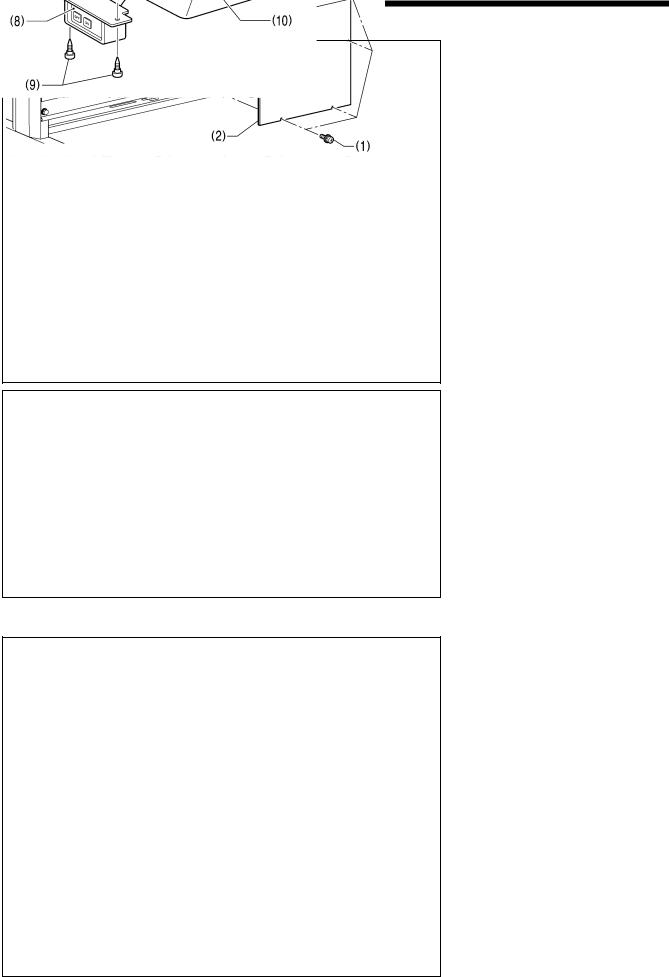
3. INSTALLATION
3-2. Installing the control box
Remove the six screws (1), and then remove the control box cover (2).
(3) Control box
(4) Bolts [4 pcs.]
(5) Plain washers [4 pcs.]
(6) Spring washers [4 pcs.]
(7) Nuts [8 pcs.]
3033B
(8) Power switch
(9) Wood screws [2 pcs.]
(10) Staples [4 pcs.]
Operator
1841B
3-3. Installing the oil pan
(1) Oil pan
(2) Nails [6 pcs.]
(3) Waste oil tank
3034B
4 |
BAS-311HN, BAS-326H |
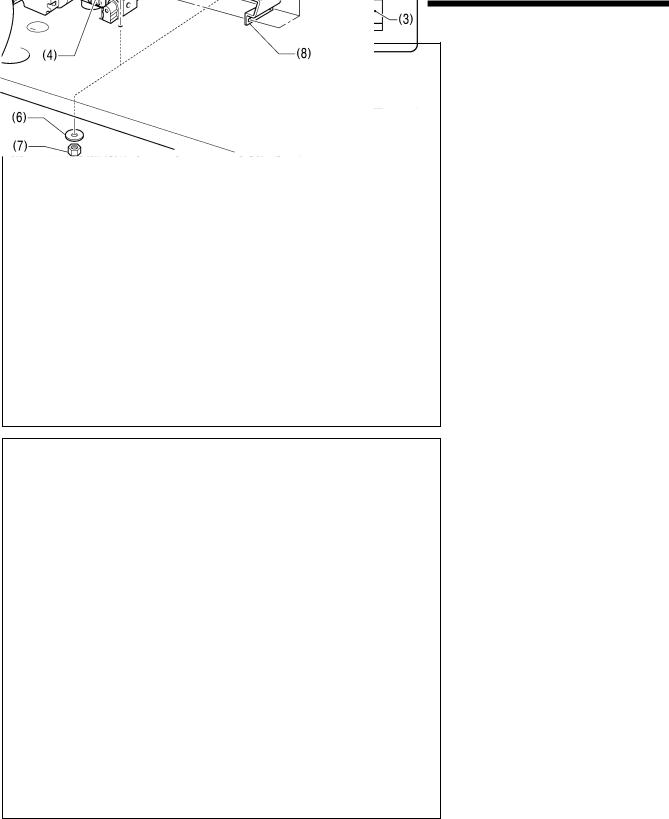
3. INSTALLATION
3-4. Installing the machine head
Pulse motor
Approx. 20 mm
Approx. 20 mm
3506B
(1)Pins [2 pcs.]
(2)Set screws [2 pcs.]
(3)Hinge rubber assemblies [2 pcs.]
Place the machine head gently on top of the oil pan.
NOTE:
•Be careful not to get the cords clamped between the machine head and the oil pan.
•When holding the machine head, do not hold it by the pulse motor. This may cause problems with operation of the pulse motor.
(4)Hinge holders [2 pcs.]
(5)Bolts [4 pcs.]
(6)Plain washers [4 pcs.]
(7)Nuts [4 pcs.]
(8)Head rest
(9)Bolts with washer [4 pcs.]
3230B
BAS-311HN, BAS-326H |
5 |
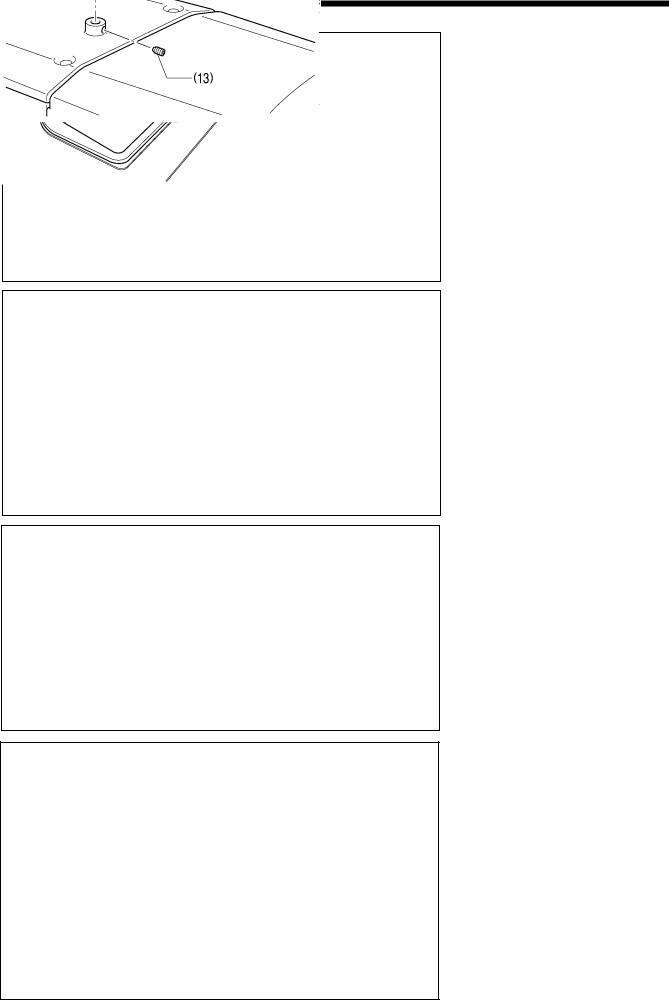
3. INSTALLATION
BAS-311HN
Needle plate
BAS-326H
Needle plate
Work clamp arm
3520B
3431B
3432B
3521B
(10)Auxiliary plate
(11)Bolts with washer [8 pcs.]
Loosen the eight bolts with washer (11), and adjust so that the auxiliary plate (10) is 0 to 0.5 mm above the needle plate.
NOTE:
•Install the auxiliary plate (10) so that it is horizontal.
If the auxiliary plate (10) is lower than the needle plate, the feed plate may get caught on the needle plate.
Move the work clamp arm all the way to the right when looking from the front of the sewing machine (the direction of the arrow in the illustration), and then gently tilt back the machine head.
NOTE:
•Three or more people should tilt back the machine head, and it should be tilted gently while being held with both hands.
•Be careful not to clamp any items such as screwdrivers under the cushion when tilting back the machine head.
(12)Bobbin winder tension assembly
(13)Set screw [1 pc.]
6 |
BAS-311HN, BAS-326H |
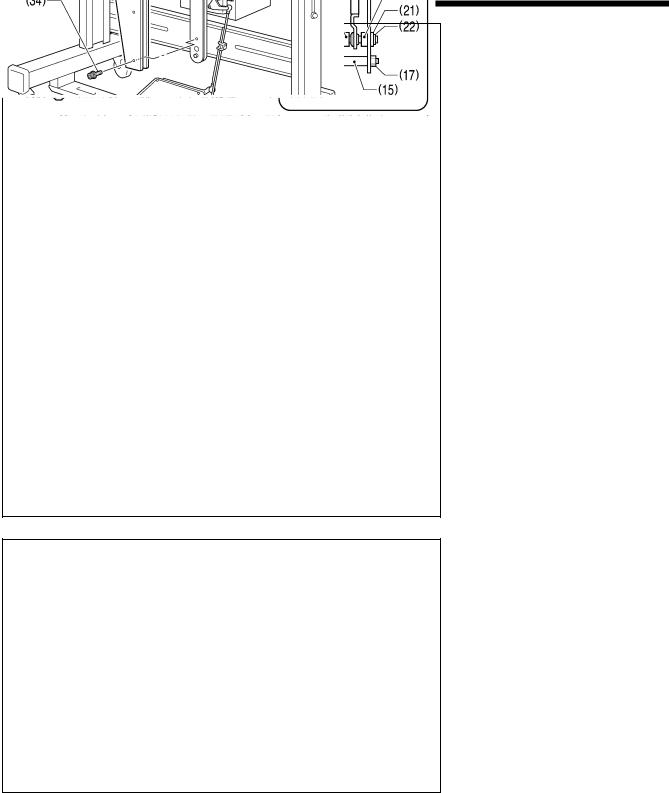
3. INSTALLATION
Be sure to install so that the side with “UP” on it is facing upward.
3534B
(14)Gas spring holders [2 pcs.]
(15)Spacer
(16)Bolt
(17)Nut
(18)Gas spring
(19)Shaft collars [2 pcs.]
(20)Gas spring shaft D
(21)Plain washers [2 pcs.]
(22)Retaining rings E [2 pcs.]
(23)Bolts [2 pcs.]
(24)Plain washers (medium) [2 pcs.]
(25)Plain washers (large) [2 pcs.]
(26)Spring washers [2 pcs.]
(27)Nuts [2 pcs.]
(28)Gas spring shaft U
(29)Retaining rings E [2 pcs.]
(30)Plain washers (small) [2 pcs.]
(31)Absorber setting plate
(32)Bolts with washer [2 pcs.]
(33)Gas spring support cover
(34)Bolts with washer [6 pcs.]
3535B
BAS-311HN, BAS-326H |
7 |
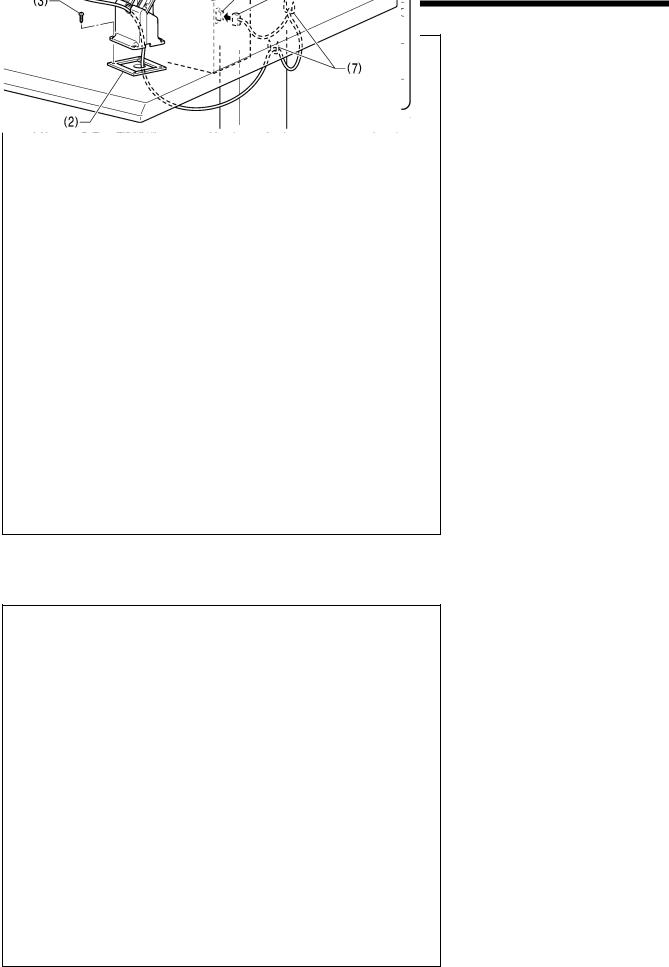
3. INSTALLATION
Gently return the machine head to its original position.
1.Remove the two screws (35), and then temporarily remove the machine head switch assembly (36).
2.Use the two screws (35) which were removed to install the machine head switch assembly (36) in the position shown in the illustration.
3.Check that the machine head switch as turned on as shown in figure [A].
*If the machine head switch is not turned on, adjust the installation position while referring to “3-16. Checking the machine head switch”.
3536B
3-5. Installing the LCD panel
3554B
(1)Cradle
(2)Rubber cushion
(3)Wood screws [4 pcs.]
(4)Setting plate
(5)Flat screws [4 pcs.]
(6)LCD panel
(7)Staples [2 pcs.]
•Pass the cord of the LCD panel (8) through the table hole, and then insert it into the (PANEL) connector (9) on the side of the control box.
•Tighten the four wood screws (3) so that the thickness of the rubber cushion (2) is 5 mm.
8 |
BAS-311HN, BAS-326H |
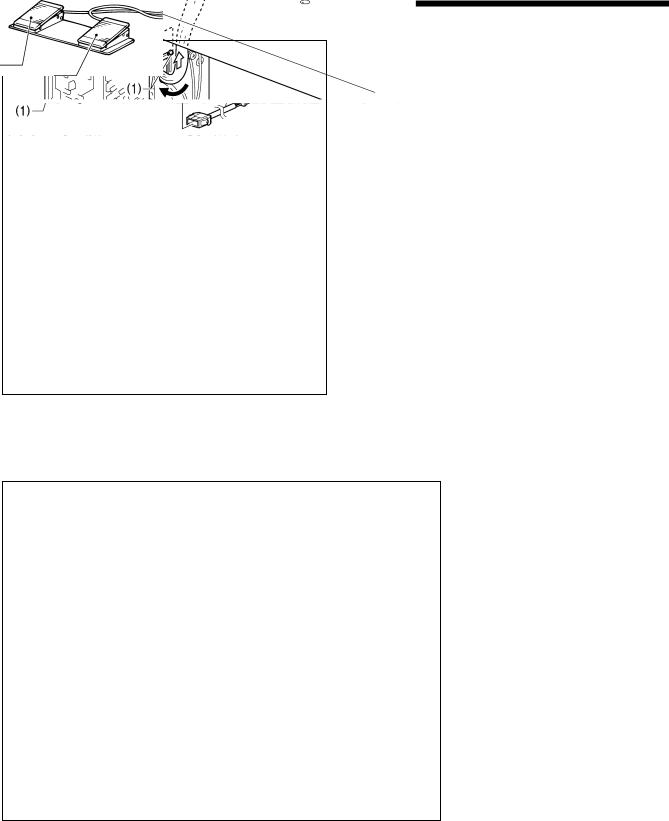
3. INSTALLATION
3-6. Installing the two-pedal foot switch
(1) Two-pedal foot switch
(2) Conversion harness
Connect the connector for the two-pedal foot switch (1) to the conversion harness (2). Insert the conversion harness (2) into the P15 (PEDAL) connector on the main P.C. board. (Refer to "3-7. Connecting the cords".)
* Be sure to make the ground connection. (Refer to “3-8. Connecting the ground wire”.)
<Two-pedal foot switch operating method>
When the work clamp switch (left) is depressed, both work clamps are lowered, and when the start switch (right) is depressed, the sewing machine starts sewing.
* The work clamp lowering method can be changed using memory switch No. 002. (Refer to "2-2. List of memory switch settings" in the "LCD Panel/Operation Panel" Instruction Manual.)
3042B
Work clamp switch (2-step)
Start switch
4923Q
3-7. Connecting the cords
1. Gently tilt back the machine head.
2. Pass the cord bundle through the hole in the work table.
3. Loosen the two screws (1), and then open the cord presser plate (2) in the direction of the white arrow and pass the cord bundle through the opening.
4. Securely connect the connectors as indicated in the table.
(Continued on next page)
NOTE:
• Check that the connector is facing the correct way, and then insert it firmly until it locks into place.
• Secure the cables with cable ties and cord clamps, while being careful not to pull on the connector.
3528B
BAS-311HN, BAS-326H |
9 |
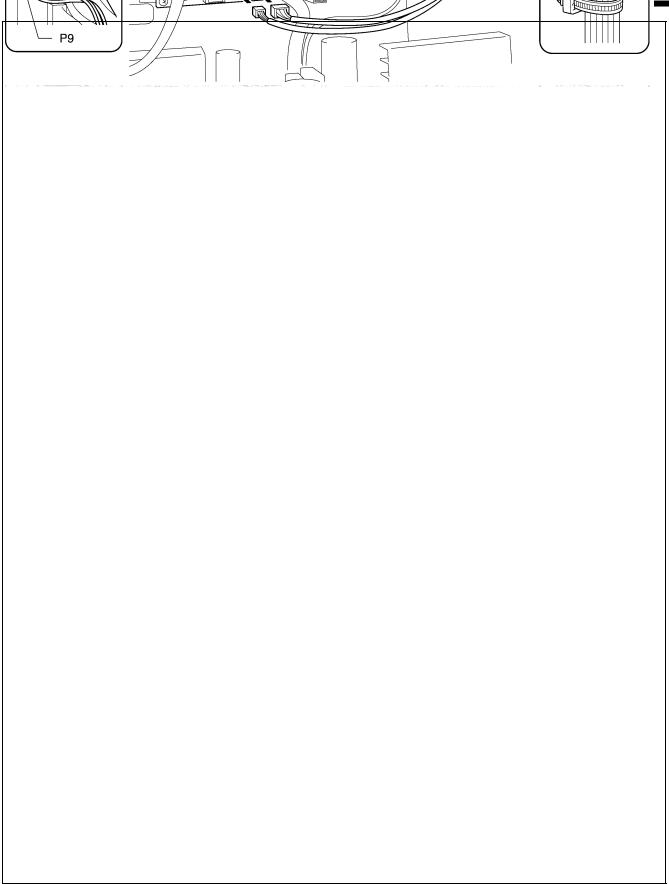
3. INSTALLATION
< Main P. C. board >
Lock the cord clamp securely.
<Removal>
Press the tab.
<Securing>
3542B
Connectors |
Connection location on |
Cord clamps / |
||
|
main P. C. board |
cable ties |
||
|
|
|||
X pulse motor encoder [5-pin] White |
P17 |
(X-ENC) |
(2) |
|
Y pulse motor encoder [5-pin] Blue |
P18 |
(Y-ENC) |
(2) |
|
Intermittent presser foot pulse motor encoder [5-pin] Black |
P19 |
(P-ENC) |
(2) |
|
Machine head switch [3-pin] |
P14 |
(HEAD-SW) |
(2) |
|
Conversion harness (two-pedal foot switch) [7-pin] White |
P15 |
(PEDAL) |
(2) |
|
Machine head memory [6-pin] |
P16 |
(HEAD-M) |
(2) |
|
Thread trimmer solenoid [6-pin] |
P2 |
(SOL1) |
(1) |
|
Digital tension solenoid / Tension release solenoid [4-pin] |
P3 |
(SOL2) |
(1) |
|
X pulse motor [4-pin] White |
P21 |
(XPM) |
(1) |
|
Y pulse motor [4-pin] Blue |
P22 |
(YPM) |
(1) |
|
Work clamp pulse motor [4-pin] Black |
P23 |
(PPM) |
(1) |
|
Home position sensor [12-pin] White |
P8 |
(SENSOR1) |
(2) (3) |
|
STOP switch [6-pin] White |
P9 |
(HEAD) |
(2) (3) |
|
Valve harness [12-pin] (pneumatic work clamp specifications) |
P35 |
(EX-OUT1) |
(2) (3) |
|
Upper thread breakage detector [2-pin] White |
P36, P9(HEAD) |
(2) (3) |
||
NOTE: Route the X, Y and work clamp pulse motor harnesses so that they do not touch the power supply P.C. board at the bottom of the control box.
10 |
BAS-311HN, BAS-326H |
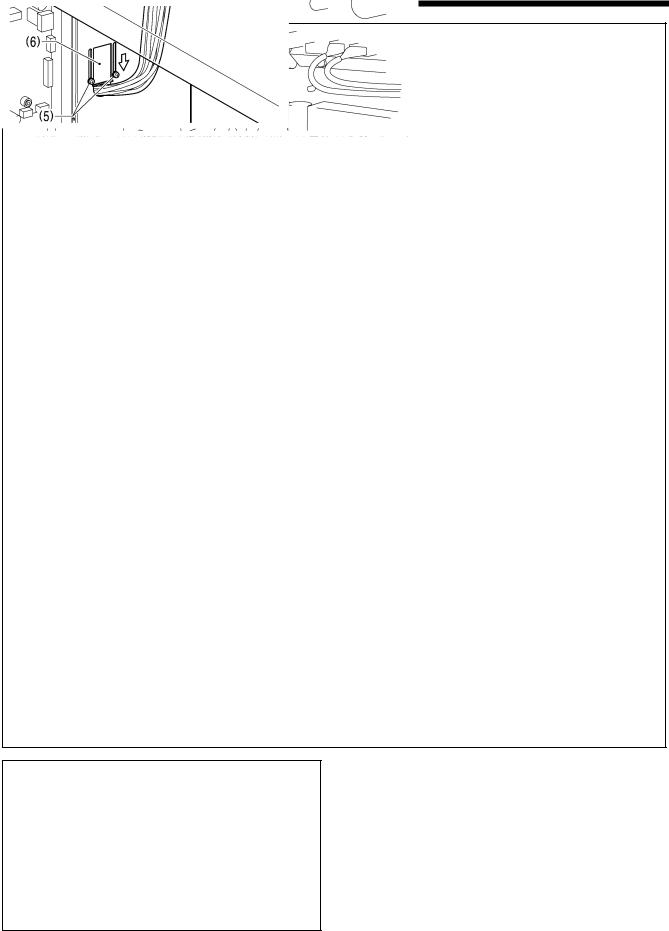
3. INSTALLATION
< Motor P. C. board >
Lock the cord clamps securely.
3537B
Connectors |
Connection location on |
Cord clamps |
|
motor P. C. board |
|||
|
|
||
Upper shaft motor [4-pin] |
UVW |
(4) |
|
Synchronizer [10-pin] |
P11 SYNC |
(2) (3) |
5. Close the cord presser plate (6) in the direction of the white arrow, and secure it by tightening the two screws (5).
NOTE:
Close the cord presser plate (6) securely so that no foreign objects, insects or small animals can get inside the control box.
6. Check that the cords do not get pulled, and then gently return the machine head to its original position.
3538B
BAS-311HN, BAS-326H |
11 |
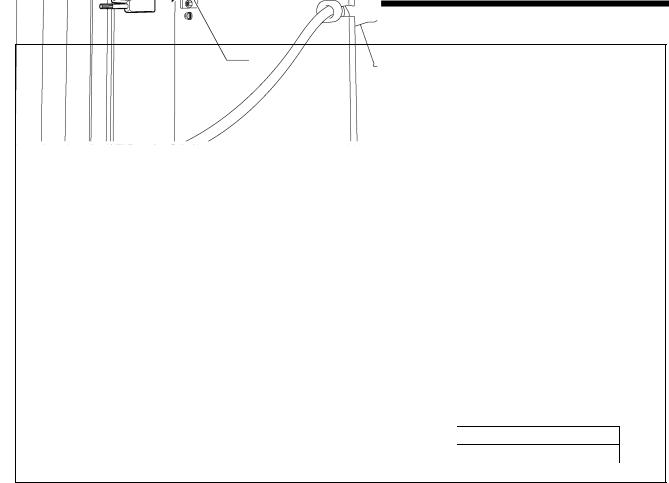
3. INSTALLATION
<LCD panel>
(PANEL)
Connector |
D-sub connector |
LCD panel [9-pin] |
(PANEL) |
3557B
12 |
BAS-311HN, BAS-326H |
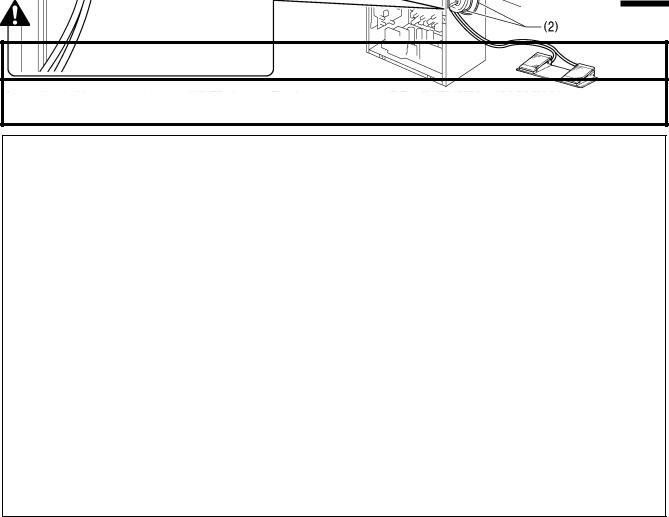
3. INSTALLATION
3-8. Connecting the ground wire
CAUTION
Be sure to connect the ground. If the ground connection is not secure, you run a high risk of receiving a serious electric shock, and problems with correct operation may also occur.
3529B
(1)Ground wire from the machine head
(2)Ground wires from two-pedal foot switch harnesses (2 wires)
• Tighten the control box cover with the six screws. Check that the cords are not clamped by the cover at this time.
NOTE: Make sure that the ground connections are secure in order to ensure safety.
BAS-311HN, BAS-326H |
13 |
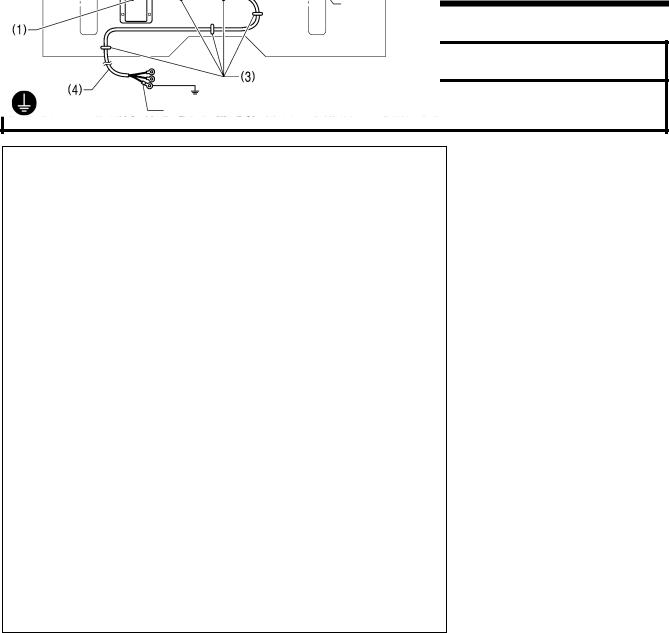
3. INSTALLATION
3-9. Connecting the power cord
 CAUTION
CAUTION
Be sure to connect the ground. If the ground connection is not secure, you run a high risk of receiving a serious electric shock, and problems with correct operation may also occur.
< Seen from underneath table >
Control box
Connect cords that match the voltage specifications.
< EU specifications
(1)Filter box
(2)Screws [4 pcs.]
(3)Staples [6 pcs.]
(4)Power cord
1.Attach an appropriate switch and cable to the power cord (4). (The green and yellow wire is the ground wire.)
2.Insert the power plug into a properly-grounded electrical outlet.
NOTE:
•Take care when tapping in the staples
(3) to make sure that they do not pierce the cords.
•Do not use extension cords, otherwise machine operation problems may result.
Leg
Green and yellow wire (ground wire)
3665B
14 |
BAS-311HN, BAS-326H |
